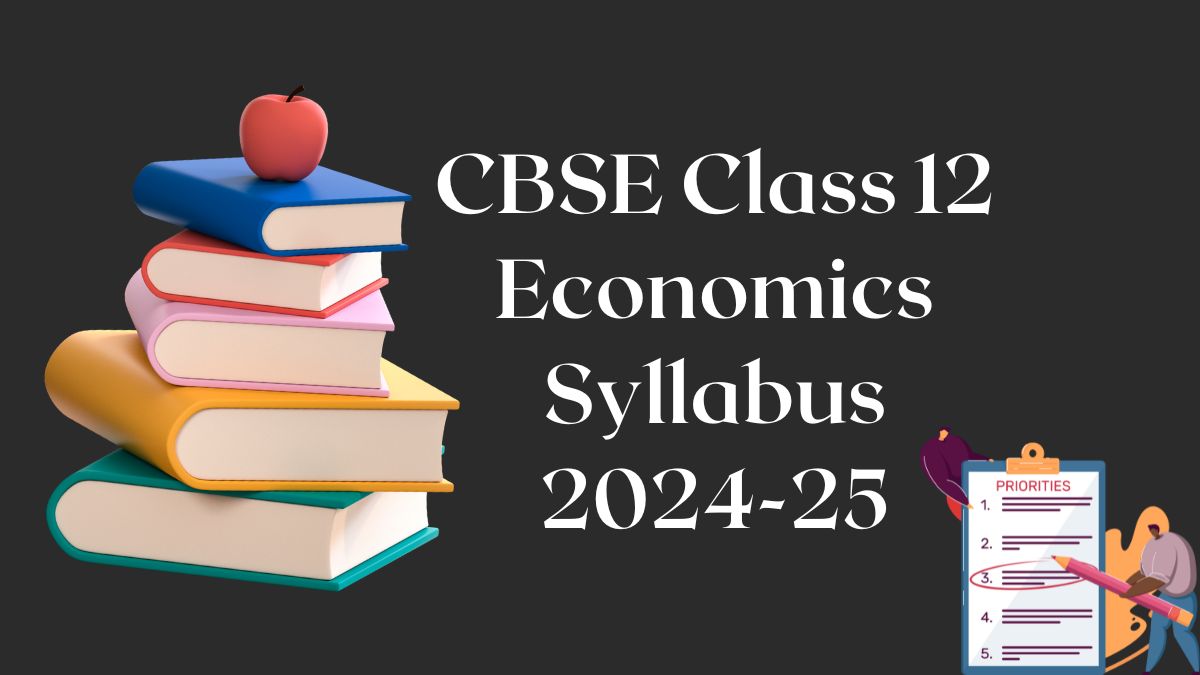This syllabus for Class 12 Economics aims to provide students with a broad understanding of economic concepts, policies, and their real-life applications. It consists of three main parts: Macroeconomics, Indian Economic Development, and Project Work.
CBSE Class 12 Economics Syllabus 2024-25
Units and Marks Distribution
Part A: Introductory Macroeconomics
| Units | Marks | Periods |
|---|---|---|
| National Income and Related Aggregates | 10 | 30 |
| Money and Banking | 6 | 15 |
| Determination of Income and Employment | 12 | 30 |
| Government Budget and the Economy | 6 | 17 |
| Balance of Payments | 6 | 18 |
| Total Marks | 40 | 110 |
Part B: Indian Economic Development
| Units | Marks | Periods |
|---|---|---|
| Development Experience (1947-90) and Economic Reforms since 1991 | 12 | 28 |
| Current Challenges facing Indian Economy | 20 | 50 |
| Development Experience of India – A Comparison with Neighbours | 8 | 12 |
| Total Marks | 40 | 90 |
Part C: Project Work
| Units | Marks | Periods |
| Project Work | 20 | 20 |
Theory Paper: Total Marks = 80 (40 for Part A + 40 for Part B)
Detailed Syllabus Breakdown
Part A: Introductory Macroeconomics
Unit 1: National Income and Related Aggregates (30 Periods)
- What is Macroeconomics?
- Basic concepts in macroeconomics: consumption goods, capital goods, final goods, intermediate goods; stocks and flows; gross investment and depreciation.
- Circular Flow of Income: (Two-sector model).
- Methods of Calculating National Income:
- Value Added or Product Method
- Expenditure Method
- Income Method
- Aggregates related to National Income:
- Gross National Product (GNP), Net National Product (NNP), Gross Domestic Product (GDP), and Net Domestic Product (NDP) – at market price, at factor cost.
- Real and Nominal GDP, GDP Deflator, and GDP & Welfare.
Unit 2: Money and Banking (15 Periods)
- Money – Meaning and Functions:
- Supply of money: Currency held by the public and net demand deposits held by commercial banks.
- Money Creation by the Commercial Banking System.
- Central Bank and its Functions (Example of RBI):
- Bank of Issue, Government Bank, Banker’s Bank.
- Control of Credit through Bank Rate, Cash Reserve Ratio (CRR), Statutory Liquidity Ratio (SLR), Repo Rate, Reverse Repo Rate, Open Market Operations, Margin Requirement.
Unit 3: Determination of Income and Employment (30 Periods)
- Aggregate Demand and Its Components.
- Propensity to Consume and Save: (Average and Marginal).
- Short-run Equilibrium Output: Investment multiplier and its mechanism.
- Meaning of Full Employment and Involuntary Unemployment.
- Problems of Excess and Deficient Demand: Measures to correct them – changes in government spending, taxes, and money supply.
Unit 4: Government Budget and the Economy (17 Periods)
- Government Budget – Meaning, Objectives, and Components.
- Classification of Receipts and Expenditures:
- Revenue Receipts and Capital Receipts.
- Revenue Expenditure and Capital Expenditure.
- Balanced, Surplus, and Deficit Budget: Measures of government deficit.
Unit 5: Balance of Payments (18 Periods)
- Balance of Payments Account – Meaning and Components.
- Balance of Payments – Surplus and Deficit.
- Foreign Exchange Rate – Types: Fixed, Flexible, and Managed Floating.
- Determination of Exchange Rate in a Free Market: Merits and demerits of each type.
Part B: Indian Economic Development
Unit 6: Development Experience (1947-90) and Economic Reforms since 1991 (28 Periods)
- State of the Indian Economy on the Eve of Independence.
- Indian Economic System and Common Goals of Five Year Plans.
- Main Features, Problems, and Policies:
- Agriculture: Institutional aspects and the new agricultural strategy.
- Industry: Industrial Policy Resolution (IPR) 1956; Small Scale Industries (SSI) – Role & Importance.
- Foreign Trade.
- Economic Reforms since 1991: Liberalisation, Privatisation, and Globalisation (LPG Policy), Concepts of Demonetisation, and GST.
Unit 7: Current Challenges facing Indian Economy (60 Periods)
- Human Capital Formation: Role in economic development; growth of the education sector in India.
- Rural Development:
- Key issues: Credit and marketing, role of cooperatives, agricultural diversification, alternative farming – organic farming.
- Employment: Growth and changes in workforce participation rates; issues in formal and informal sectors.
- Sustainable Economic Development: Meaning, impact on resources and environment, including global warming.
Unit 8: Development Experience of India: A Comparison with Neighbours (12 Periods)
- Comparison with Pakistan and China:
- Issues in economic growth, population, sectoral development, and other Human Development Indicators.
Part C: Project in Economics (20 Periods)
- Students will undertake a project to understand the application of economic principles in real-life situations.
Suggested Question Paper Design
| S.No | Typology of Questions | Marks | Percentage |
|---|---|---|---|
| 1 | Remembering and Understanding: Recall facts, terms, basic concepts, and main ideas. | 44 | 55% |
| 2 | Applying: Solve problems using acquired knowledge and apply it in a different context. | 18 | 22.5% |
| 3 | Analysing, Evaluating, and Creating: Break down information, make inferences, propose alternative solutions. | 18 | 22.5% |
| Total | 80 | 100% |
Prescribed Books
- Statistics for Economics – NCERT
- Indian Economic Development – NCERT
- Introductory Microeconomics – NCERT
- Macroeconomics – NCERT
- Supplementary Reading Material in Economics – CBSE
Note: The above books are also available in Hindi Medium.
CBSE Class 12 Economics Syllabus 2024-25 PDF Download
The CBSE has published the Class 12 Economics syllabus for the 2024-25 academic session, and it can be downloaded in PDF format. Students and educators can visit the official CBSE website to access the syllabus PDF and plan their preparation effectively. We also provided the link to download the CBSE Class 12 Economics Syllabus PDF.
CBSE Class 12 Economics Syllabus 2024-25-Click Here To Download PDF
Related Articles:

